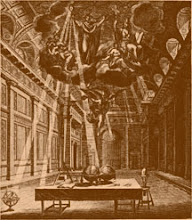What are we going to do with Masonry?
I have been pondering a potential comparison to our question of, "what do we do with Masonry." I, like many of you am just a rough ashlar that spends my days working in the Masonic mines. As such, I have come to realize over these many years the repetitive nature of all that we do.
This made me think about a little known psychologist in the early 1900's by the name of Karl Duncker. Duncker was one of the early psychologists that performed experiments that dealt with problem solving. Of course, many of you might ask, what does problem solving have to do with Masonry? We don't have any problems; at least we wouldn't if people would just do things the way we use to do them. Back when our halls were full; when brothers fought to get in line for the chairs (and that wasn't dinner chairs); you know, back when, well…when all was well.
Well let me tell you a little more about Mr. Duncker's experiments, and then maybe you can let me know what you think. Mr. Dunker use to set a table in the middle of a room and place a wide assortment of seemingly unrelated objects on the table. He would then call in a group of volunteers (subjects) and ask them to perform some task utilizing the objects set before them; none of which on the surface appeared appropriate. His goal was to see if the subjects could determine other possible uses for the objects and under what conditions.
In the first experiment, the subjects were asked to mount three small candles on the wall at eye level. Duncker had placed on the table; tacks, paper clips, paper, string, candles, and three small boxes. After pondering the situation all of the subjects realized that they could attach the boxes to the wall and use them as platforms for the candles.
In the second experiment, utilizing the same materials and instruction, Duncker filled the three boxes with the other items that had previously been placed separately on the table. This time very few of the subjects were able to solve the problem. This time the subjects viewed the boxes as serving a specific purpose, simply because they were holding the other items. Therefore, the subjects had a hard time seeing another use for the boxes.
Duncker coined this impediment to problem solving "functional fixedness." This happens when someone that is expected to solve a problem sees the object as having only one specific function (sometimes due to repetitive exposure of a singular use and under repetitive singular understanding) and it becomes much more difficult for the subject to see any other use or function for the object. Duncker considered this a very important discovery (not quite as valuable as discovering the lost word; however, maybe close in our situation). Duncker explains that this is why, in many situations, the most knowledgeable people in any subject are the least likely to deduce a good solution to a new problem in their field of expertise. In a similar fashion, education can create expertise but also functional fixedness. The experts see their tools in terms of functions that they know they serve. He suggests that neophytes may, while coming up with uninformed and even absurd suggestions, see them more creatively. In addition, he suggests that it is no accident that most scientists generally make their most original and important contributions early in their career before suffering, “functional fixedness.”
So, is Masonry suffering from functional fixedness? Here are your three boxes, now tell us “what You are going to do with Our Masonry.”
Wednesday, January 23, 2008
What Are We Going to Do with Masonry? by Br. Ronald D. Martin
Posted by
The Sanctum Sanctorum
at
1/23/2008 06:16:00 AM
![]()
![]()
Labels: Freemasonry, functional fixedness, Karl Duncker, psychology
Subscribe to:
Post Comments (Atom)


No comments:
Post a Comment